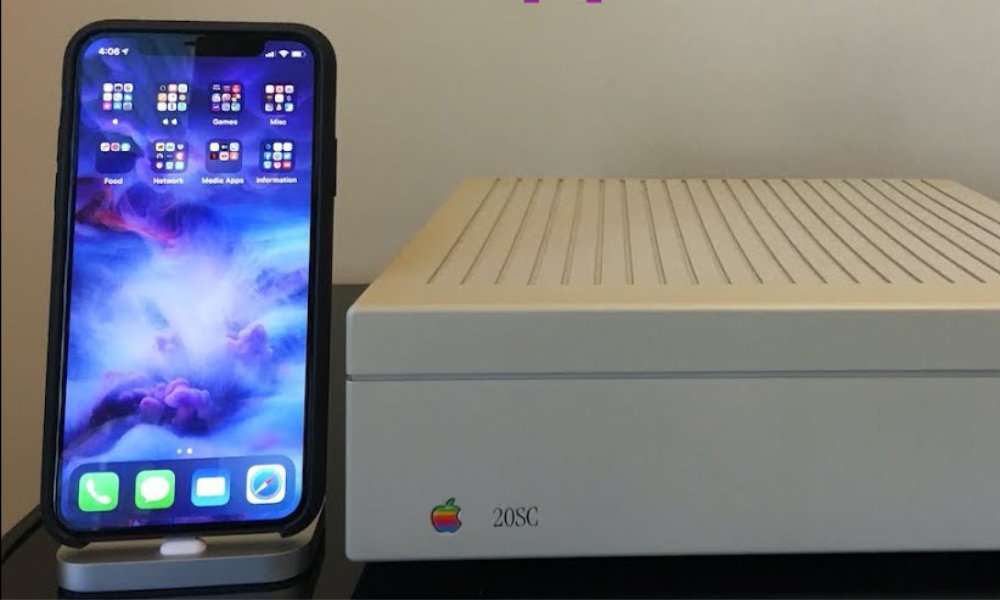Check Out This Modern iPhone Connected to a Vintage 1986 Apple Hard Drive
 Credit: napabar / YouTube
Credit: napabar / YouTube
Toggle Dark Mode
By most estimates it’s been a long time coming, but iOS 13 finally allows users to connect their iPhone or iPad to pretty much any external USB-based storage device, and while Lightning-equipped iPhones and iPads will still require you to use an adapter to make the USB connection, it actually works remarkably well.
Although most users will only ever use this feature for things like solid-state USB flash drives and camera SD cards, the truth is that anything that can interface with a Mac or PC as a mass storage device over USB should also be readable by an iPhone or iPad, or even an iPod touch, as long as you’re using iOS 13.
In fact, we already saw this last summer in the early iOS 13 betas with an Iomega Zip drive, a device that was first introduced in 1996, which worked as easily as plugging it in to one of Apple’s own Lightning to USB 3 camera Adapters, allowing an iPhone to read and write files to a Zip disk through the built-in Files app. While there were a few understandable limitations — Zip disks were notoriously slow, and the Files app naturally has no button to eject the Zip disk form the drive — it otherwise worked surprisingly well.
Now, YouTuber Niles Mitchell, aka napabar, has decided to take things back another decade, demonstrating that a modern iPhone can in fact be used to interface with a 1986 Apple Hard Disk 20SC — an Apple accessory from 15 years before the iPod, released at a time when the Macintosh had just gotten System 3.0 and a few PCs could actually run Microsoft’s new and shiny Windows 1.0 “operating environment” on top of the entirely command-line based Microsoft DOS.
The biggest trick with the Hard Disk 20SC is that USB wasn’t even on the drawing board back in 1986 — it wouldn’t begin development until eight years later in 1994. Instead, the 20SC used an older interface called SCSI (pronounced “scuzee”), short for Small Computer System Interface. The 20SC was designed to be used with the Macintosh Plus that came out that same year with a native interface for external SCSI drives, but could also be plugged into the Apple II series if users chose to add their own SCSI controller card. It was the second external hard drive that Apple ever manufactured, and the first to use the non-proprietary SCSI interface, following on the heels of the previous year’s Hard Disk 20, which was made to work solely with the Macintosh 512K.
To make the Hard Drive 20 SC work, Mitchell had to use a series of adapters, which included not only a SCSI-to-USB adapter, but because there were multiple versions of SCSI ports found on computers and devices in those days, he also needed an additional adapter to covert from the newer SCSI-2 connector on the USB adapter to the older and larger SCSI-1 ports on the Apple external hard drive.
To put things in perspective, in the video Mitchell also shows a 64 GB micro SD card from his son’s Nintendo Switch, which he notes are available in capacities of up to 1 TB in the same size for around $300. He holds this up next to the rather gargantuan 20MB Apple Hard Disk 20SC, noting that in today’s dollars with inflation factored in, this particular Apple accessory would have cost around $3,000. For 20 MB of storage.
Once Mitchell gets everything hooked up, which involves five pieces — an Apple Lightning Dock, and Apple Lightning to USB 3 Camera adapter, a USB to SCSI-2 adapter, a SCSI-2 to SCSI-1 adapter, and a SCSI terminator on the other end of the hard drive — he then uses Siri to “fire up the old hard drive” (obviously using a Siri Shortcut he created earlier just for effect), at which point you can hear it spinning up with a sound akin to a jet getting ready for takeoff.
For reasons that he admits that he can’t explain, Mitchell says that the 20SC takes three minutes and thirty seconds to appear on a Mac OS X desktop or in the iOS Files app, yet it appears immediately on Windows, Blu-ray players, and Smart TVs. After the long wait, however, the drive becomes fully functional once it shows up, and he was able to use his iPhone to play songs and open pictures from the hard drive, as well as copying the PDF owners manual onto it from his iPhone storage, and then open it and read it directly from the drive. Mitchell also notes that he found the Hard Disk 20SC surprisingly more responsive than other SCSI drives he had tested with the iPhone, such as Orb and Jazz drives.
What’s cool about this is not only that it works at all, but the fact that Mitchell is actually interfacing two pieces of Apple technology that were made almost 34 years apart. The entire video is worth a watch not only to see the magic of ancient technology and modern technology working together, but also to see just how far we’ve come from the days when hooking up external storage devices required matching up different physical connections, dealing with setting “SCSI IDs” and terminating device chains, and all to get 20 MB of storage — the equivalent of two or three songs in MP3 format. This was what life was like before USB and cheap storage, kids.






